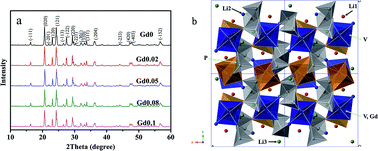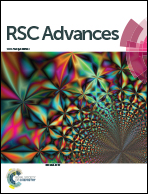A novel synthesis of gadolinium-doped Li3V2(PO4)3/C with excellent rate capacity and cyclability
Abstract
We report here the synthesis of gadolinium (Gd)-doped Li3V2−xGdx(PO4)3/C (x = 0, 0.02, 0.05, 0.08, and 0.1) cathode materials using a rheological phase method. The X-ray diffraction patterns demonstrate that all the samples have the same monoclinic structure with space group P21/n. The scanning electron microscopy images show the uniform and optimized particle size of the doped samples. The Li3V1.98Gd0.02(PO4)3/C sample demonstrates the best cycling stability and discharge rate capability. Its initial discharge capacity is 110.9 mA h g−1, which can be maintained at 103.7 mA h g−1 after 80 cycles at a discharge rate of 0.2C, and the capacity retention rate is 93.5% (at 3.0–4.3 V) and 81% (at 3.0–4.8 V), while the corresponding capacity retention rates of the undoped sample are only 80.8% and 76%. According to rate performance, the Li3V1.98Gd0.02(PO4)3/C sample shows capacity retention rates of 94% (at 3.0–4.3 V) and 86% (at 3.0–4.8 V), while the pristine sample only achieves 91% and 81.6% at the 80th cycle at 0.2C. We believe that substitution with Gd3+ can reduce charge transfer resistance and improve the diffusion of Li+ ions. It is therefore useful for improving the electrochemical performance of Li3V2(PO4)3.


 Please wait while we load your content...
Please wait while we load your content...